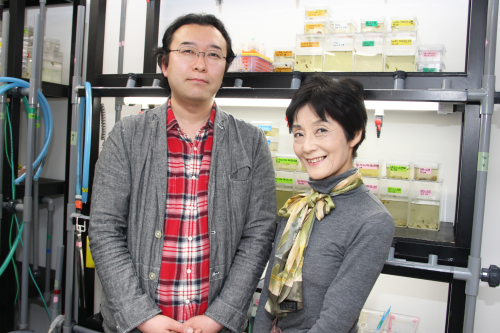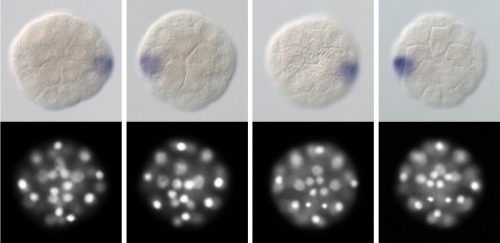The people behind the papers – Masanori Abe and Reiko Kuroda
Posted by the Node Interviews, on 19 June 2019
This interview, the 64th in our series, was recently published in Development
One of the most obvious examples of left-right asymmetry in animal bodies comes from snails: in most species or strains, the shells coil dextrally, but some coil sinistrally. The control of coiling is genetic and begins in the early embryo. Previous work has implicated the formin diaphanous in the regulation of snail shell chirality, and a new paper in Development now decisively proves its involvement, thanks to the first application of CRISPR/Cas9 gene knockouts in molluscs. We caught up with the author team behind the paper: Masanori Abe and his supervisor Reiko Kuroda, Professor at Chubu University in Japan (recently moved from Tokyo University of Science), to find out more.

Reiko, can you give us your scientific biography and the questions your lab is trying to answer?
RK During my PhD at the University of Tokyo and in my first postdoc period under Professor Stephen Mason at King’s College London, I studied chemistry and carried out research on X-ray crystallography and spectroscopy of chiral transition-metal complexes. I then moved to the Biophysics Department and worked on DNA-carcinogen/anti-cancer drug interactions using X-ray crystallography, computer graphics and molecular biology. I was appointed Associate Professor and then Professor in the Department of Chemistry, Graduate School of Arts and Sciences of the University of Tokyo, and then recently, Professor at Tokyo University of Science, and very recently Professor at Chubu University. As I am interested in chirality, my attention was inevitably drawn to the molecular mechanisms of snail coiling. I was a late starter in developmental biology, but I have now been working in the field for the last 20 years.
In 1999, I coined the term ‘chiromorphology’, which expresses the concept of my research to link macroscopic and microscopic morphological phenomena in both biology and chemistry domains through chirality. Eventually, I hope to understand the impact and the origin of the homochiral biological world [in which almost all proteins contain only L-amino acids and RNA/DNA contain D-(deoxy)ribose]. In the area of crystallography, I try to understand how billions of molecules gather to form either chiral or non-chiral crystals, and how chirality is generated, recognized, transferred and/or amplified in the solid state. In the area of spectroscopy, I have developed chiroptical spectrophotometers, which can analyze samples in their condensed phases, such as the crystalline, gel or membrane state, without the contamination of artefact signals that can arise from intrinsic macroscopic anisotropy. We have used them to explore the dynamics of secondary-structure transitions of β-amyloids and hornet silk, in addition to the crystals of organic and inorganic compounds.
Masanori: how did you come to work with Reiko, and what drives your research?
MA When I joined the Kuroda lab at the Graduate School of the University of Tokyo, I was initially not interested in snails at all, but in research on DNA recognition compounds and proteins. However, when this research got stuck, I decided to participate in the snail work. And so far, I have been very excited about the elucidation of the mechanism of left-right asymmetry determination in snails. I think it suits me to look for interesting things that people don’t normally pay attention to, and this research is just that.
How was Lsdia1 first implicated as a candidate chirality gene, and why did you need to turn to CRISPR/Cas9 to prove its role decisively?
RK We reached the conclusion that Lsdia1 is the strongest candidate for the handedness-determining gene based on positional cloning and on various experiments using pure dextral, pure sinistral and F10backcrossed lines that we had established. We found a sinistral strain that carries a frameshift mutation that abrogates full-length LsDia1 protein expression, already at the one-cell stage (published in 2016). Although we were confident about the results, we could not ignore the possibility that Lsdia1 is simply genetically linked to a true handedness-determining gene. We envisaged that directly knocking out the Lsdia1 gene by CRISPR/Cas9 would provide proof. Although only MA and RK are involved in the current work, we are grateful to all the scientists/technicians/students who worked in Kuroda lab in the past for their contributions in establishing pure and backcrossed strains, rearing the snails, and enabling positional cloning, and to the Japan Science and Technology Agency (JST) for the funding of ERATO and SORST Kuroda Chiromorphology projects (to RK, 1999-2004 and 2004-2009, respectively).
Can you give us the key results of the paper in a paragraph?
RK We have decisively identified that Lsdia1 is the long-sought handedness-determining gene of Lymnaea stagnalis by developing CRISPR/Cas9 gene editing techniques. Biallelic frameshift mutations introduced into the gene produced sinistrally coiled offspring generation after generation, in the otherwise totally dextral genetic background. We could also show that the gene sets the chirality already at the one-cell stage, the earliest observed symmetry-breaking event linked directly to body-handedness in the animal kingdom. The early intracellular chirality is superseded by the intercellular chirality during the third cleavage, leading to asymmetric expression of nodal and Pitx (two genes known to regulate chirality in vertebrates) and then to organismal body handedness.

How do you think chirality is transmitted through development?
RK This is the project we are currently working on. It is interesting that intracellular chirality within a cell is superseded by the intercellular chirality during the third cleavage (as proven by the fate of mechanically manipulated embryos at this stage), and then to the 24-cell stage when the cell fates are determined. We hope to report the results in the near future.
Left-right (LR) asymmetry is a widespread feature of animals – how much conservation do you think there is at a genetic and cytoskeletal level?
RK Although diverse mechanisms have been proposed for different phyla, we think a unified mechanism and the involvement of cellular chirality are probable. We believe that there are conserved mechanisms, given that diaphanous is a protein present in many phyla. We plan to elucidate the mechanisms of chirality establishment by LsDia1 at the molecular level, which may give insight into the conservation of the genetic control of LR asymmetry.
Do you have any advice for people wanting to do CRISPR/Cas9 mutagenesis in snails?
RK Gene editing of snails by CRISPR/Cas9 is not particularly difficult, as the method itself has already been well established in model organisms, although one must check for possible off-target effects. The most difficult aspects are raising the gene-edited eggs to adult snails, and successfully breeding them to produce the next generation.
When doing the research, did you have any particular result or eureka moment that has stuck with you?
MA Since it was not guaranteed that Lsdia1 was a handedness-determining gene, I sometimes felt anxious that the gene-edited individuals created over a long period would be wasted. At that time, the F0 individuals were starting to lay eggs, so I decided to count the number of hatched juveniles, and then felt a strong sense of discomfort. At that moment, I realized that the direction of shell coiling had changed into sinistral! The juvenile snails did not show any abnormalities except the shell-coiling inversion and moved around in the Petri dish vigorously. Then I was finally convinced that Lsdia1 was the snail handedness-determining gene. I was also surprised when I found one-cell-stage chirality.
And what about the flipside: any moments of frustration or despair?
MA It can sometimes get frustrating spending a long time caring for snails. Containers for breeding individuals should be cleaned weekly, thus I can’t take a long vacation leaving the lab. In particular, we are doing experiments with eggs just laid, but the quality of the eggs varies greatly depending on the health and age of the parent snail. It can’t be avoided in order to obtain correct results with good reproducibility.
So what next for you after this paper?
MA It was found that LsDia1 and LsDia2 give LR asymmetry to the one-cell-stage egg. Next, I would like to investigate the origin of organismal LR asymmetry by delving into the molecular level, focusing on the analysis of cytoskeleton dynamics in snails. In addition, as we have established gene editing technique for this snail, which is often used in the study of perception, learning and memory, I hope that our work will help this snail become a model organism for human disease research.
Where will this work take the Kuroda lab?
RK When one question is solved, more questions arise. We have so many interesting themes to work on: the roles of LsDia1, LsDia2 and other proteins in explaining the Dia1-dependent chirality within one cell, how the intracellular chirality is superseded by intercellular chirality (cytoskeletal dynamics), and how information on the geometrical arrangement of blastomeres at the eight-cell stage is transferred to the 24-cell stage, and then to nodal/Pitx expression, at the molecular level. My long-term research objective is to link macroscopic and microscopic phenomena, i.e. across the biological hierarchy, using chirality.
When one question is solved, more questions arise
Finally, let’s move outside the lab – what do you like to do in your spare time in Tokyo?
MA I like taking a walk doing Pokemon Go as it is good exercise. There are many interesting spots in Tokyo, historic buildings and monuments, beautiful parks and cityscapes, etc. Also I enjoy making small discoveries and surprises even in the back alleys that I had never visited before.
RK We both moved this April from Tokyo to Chubu University, Kasugai, near Nagoya. When in Tokyo, I often went to special exhibitions at the National Science Museum (such as ‘Lascaux – Cave Paintings of the Ice Age’, ‘Hunters of the Ocean’, ‘Wine – the Exhibition’ and ‘Deep Sea’) or other museums and galleries in Tokyo (e.g. ‘Winne-the Pooh – the original drawings from the V&A Museum London’ and ‘Vermeer and Dutch Art’). Once we have settled down in Kasugai, I hope to explore the area.


 (No Ratings Yet)
(No Ratings Yet)